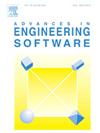Enhancing speedup in multifidelity training process by design automation to generate online reduced-order models in Convection–Diffusion–Reaction systems
IF 4
2区 工程技术
Q2 COMPUTER SCIENCE, INTERDISCIPLINARY APPLICATIONS
引用次数: 0
Abstract
In this article, a new intelligent framework is proposed by utilizing design automation in multifidelity training process to generate online reduced-order models (ROMs) in Convection–Diffusion–Reaction systems (CDR-PDE), aiming to enhance computing speedup in training and extract the representation of state–space training data. In the design automation techniques, the entire training process is divided into two layers of time divisions: (1) in the first layer, there are several large sections with equal size; (2) in the second layer, each large section includes two sub-intervals with different sizes (or may be equal) to enable significant speedup by elongating ROMs and shortening full-order models (FOMs) as much as possible. Each of sub-intervals is simulated in either FOM or ROM with least-squares methods on-the-fly by the switch criteria and algorithms in which the POD modes can be automatically selected. The main goal of this research is to enhance computing speedup in training process in CDR-PDEs without loss of the model accuracy in a robust way. During the multifidelity simulation in training process, the numbers of POD modes are upgraded automatically at the end of each sub-interval in FOM, meaning that the users do not need to determine the POD numbers in a priori. Three typical numerical examples in CDR-PDE are investigated. According to the observation from numerical studies, the POD modes are upgraded in incremental SVD and the numbers of POD modes in training process increase with the numbers of update procedures; beside that the computing speedup is obviously enhanced and excellent model accuracy can be achieved except the strong boundary layer area.
求助全文
约1分钟内获得全文
求助全文
来源期刊

Advances in Engineering Software
工程技术-计算机:跨学科应用
CiteScore
7.70
自引率
4.20%
发文量
169
审稿时长
37 days
期刊介绍:
The objective of this journal is to communicate recent and projected advances in computer-based engineering techniques. The fields covered include mechanical, aerospace, civil and environmental engineering, with an emphasis on research and development leading to practical problem-solving.
The scope of the journal includes:
• Innovative computational strategies and numerical algorithms for large-scale engineering problems
• Analysis and simulation techniques and systems
• Model and mesh generation
• Control of the accuracy, stability and efficiency of computational process
• Exploitation of new computing environments (eg distributed hetergeneous and collaborative computing)
• Advanced visualization techniques, virtual environments and prototyping
• Applications of AI, knowledge-based systems, computational intelligence, including fuzzy logic, neural networks and evolutionary computations
• Application of object-oriented technology to engineering problems
• Intelligent human computer interfaces
• Design automation, multidisciplinary design and optimization
• CAD, CAE and integrated process and product development systems
• Quality and reliability.
 求助内容:
求助内容: 应助结果提醒方式:
应助结果提醒方式:


